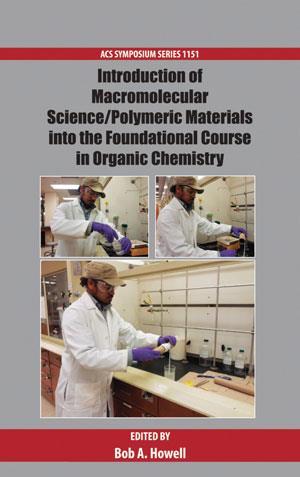Introduction of macromolecular science/polymeric materials into the foundational course in organic chemistry
Bob A Howell (ed.)
OUP USA
2014 | 200pp | £97 (HB)
ISBN 9780841228788
http://amzn.to/1uemek6

A volume of the ACS Symposium Series, this book seeks to address a gap in the teaching of polymer science in undergraduate organic chemistry. In doing so, it provides a useful resource for instructors wishing to reinforce their teaching of concepts in fundamental organic chemistry with material that serves to better engage students in the applied and cross-disciplinary aspects of the subject. Indeed, the authors highlight polymer chemistry as a link to many other areas of physical and environmental sciences and engineering and as a natural bridge between taught material and industrial practice. Their aim is of clear value in the current climate of increasing emphasis upon the employability of chemistry graduates.
Some of the included material is already commonly embedded in early undergraduate organic courses, for example poly(ethylene terephthalate) as an extension (pun intended) of transesterification, radical polymerisation, and broad aspects of the chemistry of nucleic acid, protein and polysaccharide biopolymers. The breadth and depth of coverage thereafter is excellent, with distinct coverage of polymer types that serve to reinforce the teaching of aldol and Michael chemistry, ester hydrolysis and the chemistry of acetals and ethers. The ultimate list reads as a comprehensive coverage of the standard reaction types found in many an undergraduate organic chemistry textbook. Also, occasionally a toe is dipped into the waters of thermodynamics, conformational analysis and stereochemistry, kinetics, olefin metathesis polymerisation and analytical techniques, to further complement broad student engagement across the organic chemistry sub-disciplines.
Multiple authors have contributed individual chapters to this work. As a result, it is occasionally repetitive, including a somewhat disjointed coverage of nylon syntheses – an extremely well-known context for the discussion of amide chemistry beloved of more than one author whose services might have been better supported with more cohesive editing of the volume overall. However, the book is otherwise very well-served by thorough indexing, referencing, frequent pedagogical insight and an entertaining historical context to many of the key advances of polymer science. As a source of clearly-presented material drawn from original literature, this title will support the assiduous academic instructor well.
Purchase Introduction of macromolecular science/polymeric materials into the foundational course in organic chemistry from Amazon.co.uk









No comments yet